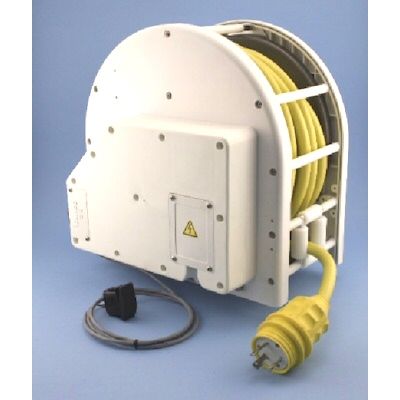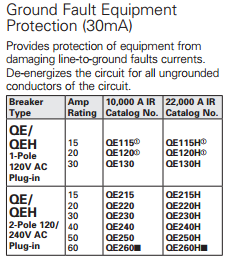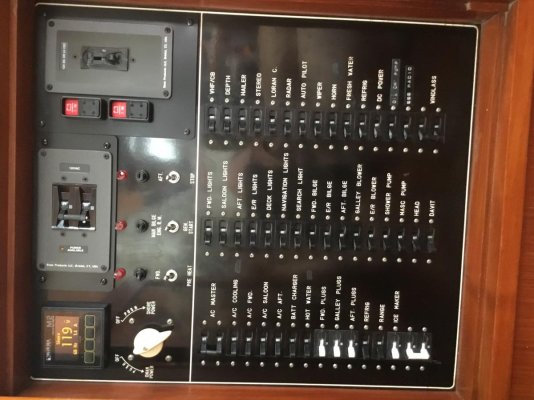Thank you CMS.
So to summarize:
You need a breaker that trips both hot and neutral within 10' of your shorepower inlet and that breaker needs to be an ELCI or RCD device.
If you desire your vessel to be ABYC compliant then yes you would need an ELCI or RCD main breaker.
In addition, the NEC requires an ELCI or RCD breaker at the marina's shore power receptacle.
Unfortunately that is
not what they currently require but it would be the correct way to phase in this new piece of code.
In the case of my boat's power system that would require two two pole breakers and ELCI/RCD's (one at the pedestal and another within 10' of the shore power inlet) in addition to the one on the main power panel and in addition to the GFCI's that protect the galley/head outlets.
Wow, there are a lot of breakers and ELCI/RCD's involved in shore power. I wonder who wrote these rules requiring multiple ELCI's or RCD's, the electrical component manufacturer's?
David
Marina's only need to change to ELCI protection if upgrading the system. This will leave hundreds oft thousands of vessels without land based ground fault protection for many years to come.
I have posted this here before but many folks simply don't understand the impact of the NFPA/NEC requirements and the shoddy wiring we have on boats. It is a real problem and getting worse very time a new marina needs to comply.
NFPA/NEC Shore Based Mess:
The current NFPA 70 / NEC requirements
Article 555 Marinas & Boatyards, which rolled out in 2011, requires a 100mA ground fault protection level for marina docks. In the upcoming 2017 NFPA 70 / NEC 555 this maximum level is reportedly going to drop from 100mA to 30mA.
The Problem:
#1 NFPA 70 / NEC requirements do not mandate protection at each dock pedestal, which would be the only prudent way to adopt or phase this into an entire industry where the safety standards are
voluntary and arguably grossly ignored.
As I type this I am currently waiting for a customers phone to cool down so we can continue troubleshooting his shore system via video messaging. He is in the BVI and can't find a decent electrician to save his life. So far we've found on-board AC neutral bonded to AC Earth and his two 30A shore inlets have common neutral bonding. Somewhere in his travels he had a failed 8kW generator ripped out, by some hacks, who left a ghost transfer switch and ran the ghost wires to where ever they found an open terminal. It is a freaking mess, a mess I repeatedly tried to talk him into fixing before he headed off cruising. "seems to work" he'd say.... He began complaining of issues when his vessel began tripping
up to code marina's and shutting entire docks down. The non-transients were none too happy and the marinas finally told him not to plug in..
As a result of NFPA/NEC not requiring ground fault protection at the pedestal level, for each boat, any vessel plugging into a dock pedestal that is protected by an
upstream ground fault device can create nuisance trips for every boat on that feed.
Shore based ground fault devices that cover multiple pedestals (boats), can result in a nuisance trip that depowers all the boats on that string and create a lost power situation to all of those vessels, just as my customer has done, at no less than 3 or 4 marinas since leaving Maine.
This NFPA / NEC roll out has already cost boaters significant $$ in destroyed battery banks etc.. Unfortunately the boaters who lost out may not have been the ones who created the problem just the recipient of what I often refer to as
Darryl & Darryl wiring, for those old enough to get the Newhart reference.. No offense to any Darryl's out there....
The NFPA / NEC ground fault requirements are only serving to expose the horrendous wiring that has gone on in the marine industry for far too long. Even if your boat is properly wired, to ABYC standards, you can still suffer the consequences of Darryl & Darryl hack jobbing their own boat because teh NFPA/NEC requirement is not at the power pedestal/individual boat level.
For what it is worth I have very infrequently come across an owner who believed it was their boat creating the leakage or corrosion issues. In almost all cases it starts out as "
someone else's problem" until the fault is found on-board...
#2 Far too many boats out there are not wired to meet or exceed the ABYC safety standards. The NFPA / NEC could really care less about this, it's not their issue. When you plug an incorrectly wired vessel into the new NFPA /NEC shore standards, requiring ground fault protection, it can now becomes everyone's issue not just the problem vessel.
Boats that are not wired to current ABYC standards, as a group, have very, very high ground fault percentages. For example the number of boats I measure with AC ground
ing (GREEN) and AC Neutral (WHITE) bonded on-board the vessel is in the range of 35-40% +/-. This is INSANE, but it is the reality of a
voluntary standard that has gone largely ignored by boatowners and far too many folks who call themselves marine electricians..
Bottom Line? Improperly wired vessels, vessels not wired to ABYC standards, can cause nuisance tripping of shore ground fault interrupters.
The sheer age of many vessels also means some of them have equipment that is so antiquated that it too creates an inadvertent neutral to grounding bond.
#3 The Rx?
Marina Rx: Marina's who want happy customers should ideally install a ground fault device at each pedestal so one boat can not take out an entire dock or entire group of vessels. This is in compliance with NFPA 70 / NEC and actually exceeds the minimum requirements. By installing a ground fault device at each pedestal this prevents Darryl & Darryl's stellar wiring job from taking out your boat when they create a nuisance trip.
Marina's also need to comprehend and understand that
leakage is additive. If we have ten boats each leaking 4 mA, which is not even enough for each boat to trip an individual 110V 5mA GFCI, those ten boats together can trip a single 30 mA ground fault device.
Marina's should prohibit vessels that cause a nuisance trips, from plugging into their system, until the fault has been corrected. If a vessel is tripping a 100mA threshold device (and this is not due to additive leakage) this creates a very dangerous potential for electric shock drowning.
The issue & mess of nuisance tripping will only get worse when the NEC drops to 30mA in 2017..
Marina's need to fully understand the new requirements and be trained on how to conduct spot audits and to check for individual vessel issues that would otherwise create problems for the rest of their customers. Or do it right and install a 30mA device at each pedestal, this way only the offending customer is left without power..
When a marina is re-wired they now need to become in compliance with the current shore based standards. Shore standards extend to the dock pedestal receptacle, and ABYC standards begin at the shore power cordset.
This problem of nuisance tripping is only going to get worse, much worse as time goes on and more and more marinas become in compliance with the NFPA 70 / NEC requirements. Once the code drops to 30mA, to protect multiple pedestals, it will become even worse.
Boat Owner Rx: Wire your vessel to the current ABYC standards and you will no longer create dangerous situations, power loss or dead batteries for those around you who do have properly wired boats.
Two Easy Tests for 120V 30A Service (these two tests barely scratch the surface but its a start):
1- Use a high resolution AC clamp meter set to measure A or mA. Extech, Yokogowa and Fluke all make excellent AC leakage clamp testers. Ideally every marina should own one. Power up your on-board AC devices (hopefully all of them) & place the clamp around your shore power cord. The reading should be 0.0A. Any reading above this is indicating an amperage imbalance between the hot and neutral AC conductors and indicating that this missing current is leaking elsewhere eg: into the water..
2- One of the easiest tests or starting points is to physically unplug your vessel from the pedestal and be sure your inverter is decoupled from DC so it does not auto-invert. Make sure any manual transfer switches are set to SHORE. Now test for continuity between AC WHITE/Neutral and AC GREEN/Earth/Grounding pins at the shore end of the cord or at your on-board grounding bus and neutral bus.. There should be no continuity.
If you find issues you are unsure of I would suggest bringing in a professional....





